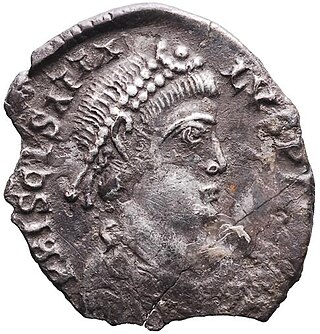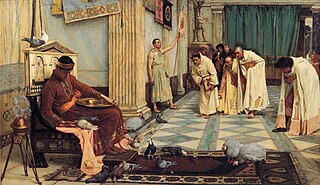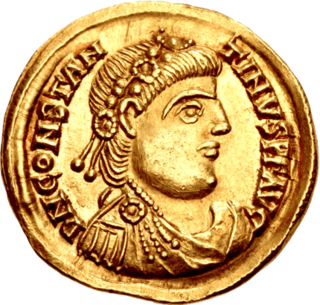
Honorius was Roman emperor from 393 to 423. He was the younger son of emperor Theodosius I and his first wife Aelia Flaccilla. After the death of Theodosius in 395, Honorius, under the regency of Stilicho, ruled the western half of the empire while his brother Arcadius ruled the eastern half. His reign over the Western Roman Empire was notably precarious and chaotic. In 410, Rome was sacked for the first time since the Battle of the Allia almost 800 years prior.
The 400s decade ran from January 1, 400, to December 31, 409.

Year 410 (CDX) was a common year starting on Saturday of the Julian calendar. At the time, it was known as the Year after the Consulship of Honorius and Theodosius. The denomination 410 for this year has been used since the early medieval period, when the Anno Domini calendar era became the prevalent method in Europe for naming years.
The 380s decade ran from January 1, 380, to December 31, 389.
The 420s decade ran from January 1, 420, to December 31, 429.

Year 409 (CDIX) was a common year starting on Friday of the Julian calendar. In the Roman Empire, it was known as the Year of the Consulship of Honorius and Theodosius. The denomination 409 for this year has been used since the early medieval period, when the Anno Domini calendar era became the prevalent method in Europe for naming years.

Year 412 (CDXII) was a leap year starting on Monday of the Julian calendar. At the time, it was known in Europe as the Year of the Consulship of Honorius and Theodosius. The denomination 412 for this year has been used since the early medieval period, when the Anno Domini calendar era became the prevalent method in Europe for naming years.
The 390s decade ran from January 1, 390 to December 31, 399
The 410s decade ran from January 1, 410, to December 31, 419.

Year 411 (CDXI) was a common year starting on Sunday of the Julian calendar. At the time, it was known in Rome as the Year of the Consulship of Theodosius without colleague. The denomination 411 for this year has been used since the early medieval period, when the Anno Domini calendar era became the prevalent method in Europe for naming years.

Year 384 (CCCLXXXIV) was a leap year starting on Monday of the Julian calendar. At the time, it was known as the Year of the Consulship of Ricomer and Clearchus. The denomination 384 for this year has been used since the early medieval period, when the Anno Domini calendar era became the prevalent method in Europe for giving names to years.

Year 423 (CDXXIII) was a common year starting on Monday of the Julian calendar. At the time, it was known in Rome as the Year of the Consulship of Marinianus and Asclepiodotus. The denomination 423 for this year has been used since the early medieval period, when the Anno Domini calendar era became the prevalent method in Europe for naming years.

Constantius III was briefly Western Roman emperor in 421, having earned the throne through his capability as a general under Honorius. By 411 he had achieved the rank of magister militum, and in the same year he suppressed the revolt of the usurper Constantine III. Constantius went on to lead campaigns against various barbarian groups in Hispania and Gaul, recovering much of both for the Western Roman Empire. He married Honorius's sister Galla Placidia in 417, a sign of his ascendant status, and was proclaimed co-emperor by Honorius on 8 February 421. Constantius reigned for seven months before dying on 2 September 421.

Constantine III was a common Roman soldier who was declared emperor in Roman Britain in 407 and established himself in Gaul. He was recognised as co-emperor of the Roman Empire from 409 until 411.

The end of Roman rule in Britain occurred as the military forces of Roman Britain withdrew to defend or seize the Western Roman Empire's continental core, leaving behind an autonomous post-Roman Britain. In 383, the usurper Magnus Maximus withdrew troops from northern and western Britain, probably leaving local warlords in charge. In 407, the usurper Constantine III took the remaining mobile Roman soldiers to Gaul in response to the crossing of the Rhine, and external attacks surged. The Romano-British deposed Roman officials around 410 and government largely reverted to the city level. That year Emperor Honorius refused an appeal from Britain for military assistance. The following decades saw the collapse of urban life and the beginning of Anglo-Saxon settlement.

Constans II was the son of Western Roman emperor Constantine III, and served as his co-emperor from 409 to 411. Constans was a monk prior to his father being acclaimed emperor by the army in Britain in early 407, an act of rebellion against the ruling emperor Honorius. He was summoned to Gaul, appointed to the position of caesar (heir) and swiftly married so that a dynasty could be founded. In Hispania, Honorius's relatives rose in 408 and expelled Constantine's administration. An army under the generals Constans and Gerontius was sent to deal with this and Constantine's authority was re-established. Honorius acknowledged Constantine as co-emperor in early 409 and Constantine immediately raised Constans to the position of augustus (emperor), theoretically equal in rank to Honorius as well as to Constantine. Later in 409 Gerontius rebelled, proclaimed his client Maximus emperor and incited barbarian groups in Gaul to rise up. Constans was sent to quash the revolt, but was defeated and withdrew to Arles. In 410, Constans was sent to Hispania again. Gerontius had strengthened his army with barbarians and defeated Constans; the latter withdrew north and was defeated again and killed at Vienne early in 411. Gerontius then besieged Constantine in Arles and killed him.
Marcus was a Roman usurper who was proclaimed Emperor of Roman Britain. He was killed later that same year in a subsequent mutiny.
Gratian or Gratianus was a Roman usurper in Roman Britain from 406-407.

The Valentinian dynasty was a ruling house of five generations of dynasts, including five Roman emperors during late antiquity, lasting nearly a hundred years from the mid fourth to the mid fifth century. They succeeded the Constantinian dynasty and reigned over the Roman Empire from 364 to 392 and from 425 to 455, with an interregnum (392–423), during which the Theodosian dynasty ruled and eventually succeeded them. The Theodosians, who intermarried into the Valentinian house, ruled concurrently in the east after 379.












